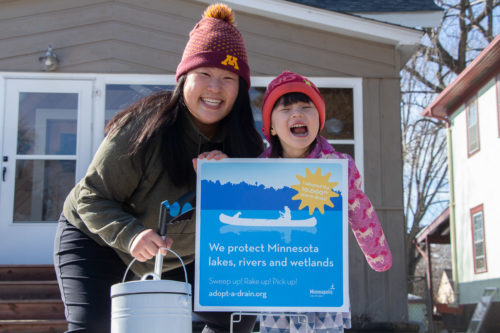Preventing Water Pollution
In order to protect our water quality, we need to prevent polluted stormwater runoff from reaching the Mississippi River and other waterbodies. We can accomplish this using a wide variety of tools and actions.
Stormwater Best Management Practice (BMP) is a term that refers to a wide variety of land-care practices and green infrastructure designed to prevent and/or treat polluted stormwater runoff. A stormwater BMP can be small and site-specific (like a raingarden that captures rainwater from part of a house’s roof) or much larger and regional in scope (such as treatment train that treats runoff from an entire block or neighborhood).

Some common examples of stormwater BMPs include:
- raingardens;
- street sweeping;
- adopting a stormdrain;
- rainbarrels/cisterns;
- permeable pavers;
- erosion control practices at construction sites; and
- stormwater retention ponds.
If you’d like to take a deep dive on all the different BMPs currently in use, the Minnesota Stormwater Manual is the definitive guide to managing stormwater runoff in Minnesota.
You can see examples of the MWMO’s work implementing stormwater BMPs in our project pages. In this section, however, we’ll focus on site-specific stormwater BMPs that can be used by residents in their own communities.
Everyday Actions
Whether you live in an apartment, a house or a condo, everyone can take action to keep water clean in our communities. Adopting a stormdrain, picking up your pet’s waste, and supporting groups and policies that help protect clean water are all meaningful ways to improve the environment.
Lawn Care
Did you know that many lawn care practices create pollution in our waterways? Grass clippings, leaves, fertilizer and other pollutants can wash into the streets, through the stormdrains and into nearby waterbodies. We’ll teach you how to keep your lawn lush and green while protecting the environment.
Fall Yard Care
Fall is a beautiful time to be outdoors in Minnesota — and a critical time for yard care. Cooling temperatures make fall the perfect season for planting new grass, pulling weeds, aerating the soil and taking extra steps to ensure a healthy comeback for your lawn next spring. Protect your lawn and our waterways with our simple tips.
Snow and Ice Removal
Did you know that many Minnesota lakes and rivers are contaminated with chloride? This toxic chemical comes from the salt and deicers we use to keep pavements ice-free in the winter. You can help protect our waterbodies by fighting snow and ice the smart way this winter.
Native Plants
Native plants can provide an attractive, cost-effective and environmentally friendly alternative to traditional lawns and landscapes. In addition to providing valuable food and habitat for native butterflies, birds and other wildlife, native plants have deep roots that soak up stormwater, break up compacted soil and help infiltrate runoff into the ground.
Permeable Pavers
Permeable pavers allow stormwater to soak into the ground by running down into the gaps between pavers. The pavers are installed over one or more base layers of stone and/or sand. In addition to providing a stable base for the pavers, these base layers provide drainage capacity and allow runoff to infiltrate the ground beneath.
Rainbarrels
Rainbarrels capture stormwater runoff from rooftops and store it so that it can be reused for irrigating plants during dry spells. In addition to reducing the amount of potable water used for watering plants, rainbarrels also help add capacity to city stormsewer systems by capturing part of the first flush of a rain event.
Raingardens
Raingardens are bowl-shaped (depressed) gardens with sandy soils and deep-rooted native plants. They act like filters on the landscape, capturing stormwater runoff and letting it soak into the ground, where the soils naturally filter out harmful pollutants.
Trees
Trees help protect water quality by capturing, storing and using rainfall. This reduces the amount of runoff that carries pollution off of the landscape and into nearby rivers and lakes. A healthy and robust tree canopy is especially important in an urban environment.
Good Neighbor Guide (PDF, 21 pages, 7 MB)
Mississippi Watershed Management Organization
The Good Neighbor Guide is an educational booklet developed by the MWMO. Designed for residents in urban areas, it explains how individuals can take action in their own yard and community to help make sure we all have clean water. Filled with fun graphics and simple, plain language, the Good Neighbor Guide is designed to be accessible to people with no prior knowledge of environmental issues. Although it offers tips on preventing water pollution at home, it is not a “how-to” manual so much as a field guide that explains “why” residents should care about protecting water quality and habitat. It explains how urban stormwater runoff carries pollutants to waterbodies and offers seasonal yard care tips and landscaping ideas to help trap pollutants before they reach the stormdrain.
Slow it. Spread it. Sink it! A Homeowner’s Guide to Greening Stormwater Runoff (PDF, 7.1 MB, 48 pages)
Resource Conservation District of Santa Cruz County (California)
This photo-filled guidebook details a wide range of stormwater control measures that homeowners can implement on their own properties. Topics include stormwater best management practices, potential problems, site constraints and example projects.
A Homeowner’s Guide to Stormwater Management (PDF, 1.7 MB, 32 pages)
Philadelphia Water Department (Pennsylvania)
In addition to raingardens and other home stormwater control measures, this guidebook includes helpful tips on vehicle maintenance and lawn care. It also covers some topics specific to northern climates, such as winter deicing practices.
The Homeowner’s Guide to Stormwater (PDF, 3.5 MB, 28 pages)
Lancaster County Conservation District (Pennsylvania)
In addition to covering all the basics, this handy guidebook features templates to help you develop a stormwater management plan for your property.
Sustainable Landscape Systems for Managing Storm Water – 2nd Edition (PDF, 12 MB, 73 pages)
Ohio State University Extension
A highly detailed and comprehensive manual for managing stormwater runoff with sustainable landscape features. Covers everything from site selection to installation and maintenance.